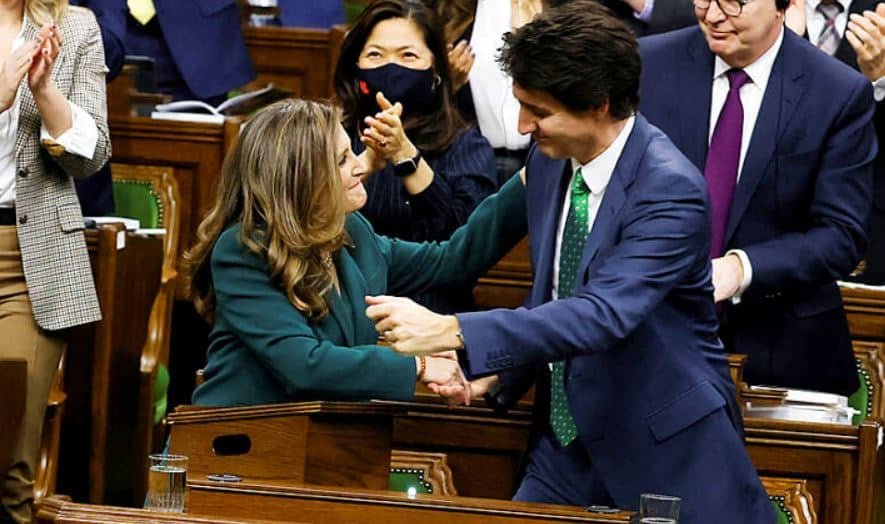Canadian industries seeking to slash their carbon footprint can expect $83 billion in clean investment tax credits after the federal government of Canada unveiled its 2023 budget.
The 2023 federal budget includes tax credits for these three investments – clean electricity, clean-tech manufacturing, and hydrogen. Adding investment credits in carbon capture and storage brings the total tax incentives to about $83 billion through to 2034-35.
Canada’s Clean Investment Tax Credits
The Canadian government said the spending is crucial to bolster the clean energy transition. It is also in response to other countries’ subsidies, particularly the U.S. Inflation Reduction Act passed in August 2022. IRA unlocked $369 billion to help heavy industries decarbonize through production tax credits.
Deputy Prime Minister Chrystia Freeland, who introduced the federal budget, noted that:
“In what is the most significant economic transformation since the Industrial Revolution, our friends and partners around the world, chief among them the United States, are investing heavily to build clean economies.”
The largest focus of the tax credits is on clean electricity, which costs more than $6 billion over the first 5 years beginning in 2024. That amount will go up to over $25 billion until 2034-35.
Indigenous-owned companies and provincial utilities can benefit from the clean tax credits.
Cleantech manufacturing will get about $11 billion in credits while carbon capture will take over $12 billion through to 2034-35.
The clean hydrogen credit is worth about $5.6 billion over 5 years. Higher rebates go to projects that produce the cleanest hydrogen.
Some industry players believe that the credit package for clean electricity is the most significant for meeting Canada’s climate goals.
Canada adopted construction-focused project support, while the US opted for operational incentives depending on production volumes. In a sense, Canada has to offer more to compete with the US which rolled hundreds of billions of tax incentives.
Canada’s Version of CCfDs
Still, the federal budget wins praises for advancing the country’s transition to clean energy. But because it’s not covering operations, Canada has to have carbon pricing backstop up its sleeve. This is where its promised carbon contracts for difference (CCfDs) becomes important.
CCfDs are a kind of insurance that enable investors to hedge against the possibility that the carbon tax will be eliminated by the future government. Tax scrapping in the future is the major reason why the oil and gas industry leaves carbon capture technology on the shelf.
The industry didn’t have much from the budget, apart from minor changes in last year’s carbon capture incentives. It will receive a 50% tax credits.
The CCfD will offer certainty to industry on future carbon pricing and credits. The policy will ensure that the carbon tax in the country remains relevant for years to come.
In other words, companies can enter into contracts with the government trusting that they can recoup their investments in carbon capture even if the carbon tax is scrapped later on.
But just like other policies, these contracts are still under consultation.
The $15 Billion Canada Growth Fund
The CCfD will be implemented through a $15 billion Canada Growth Fund. The Fund was part of last year’s budget announcement.
Though key details about CCfD are still lacking, the largest oilsands producers via its group, Pathway Alliance, praised the budget. The group is looking forward to having a “better understanding of the government’s intentions for CCfDs”.
However, some analysts think that the federal gov’t needs to pump in more money to incentivize investments in clean energy and reach its climate change targets.
A Fixed Price for Carbon Credits, not Carbon Tax
Other industry experts believe that the proposed CCfDs program is too generous. That’s largely because they think that the Liberals seem to put a fixed price for carbon credits, not carbon tax.
Climate campaigners find that weaker than the opposite – a fixed carbon tax is a stronger means to compel polluters to cut their emissions. They said that the CCfD program may cost the Canadian government more money than expected.
But the proponents may find it more limiting to allow heavy emitters to pay for their pollution through carbon tax. It’s because they will pay only for a certain percentage of their total carbon footprint.
On the contrary, allowing them to gain carbon credits for the carbon they captured will prompt them to abate their entire footprint. That’s because such credits won’t be subject to the carbon tax.
Other industry leaders argue that the spending will be a bigger burden to the taxpayers, not the industry. The cost of the transition will shift too much onto those who pay the taxes.
But overall, many find the budget praiseworthy by prioritizing investments on the clean energy transition.
The 2023 federal budget, which includes 268 pages, will be up for intense debate and scrutiny in the coming months.

